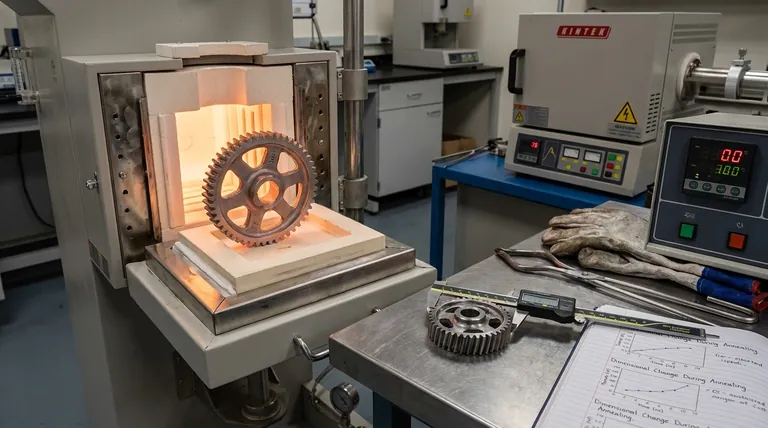Yes, annealing can absolutely affect a part's dimensions. This change is not typically a uniform growth or shrinkage, but rather a form of distortion, warping, or settling that occurs as the process relieves locked-in internal stresses from prior manufacturing steps like machining, welding, or cold working.
The critical point to understand is that annealing doesn't cause a material to inherently expand or contract. Instead, it allows the material to relax into its lowest energy state, revealing the dimensional instability that was already present as internal stress.

The Core Mechanism: Why Annealing Changes Shape
The primary purpose of annealing is to relieve internal stresses and increase a material's ductility. The dimensional change is a direct consequence of this stress relief.
What Are Internal Stresses?
Nearly every manufacturing process locks some amount of mechanical stress into a material. This can come from casting, welding, aggressive machining, or cold working (like bending or stamping).
These stresses are like tightly wound springs trapped within the material's atomic structure. The part is dimensionally stable only because these internal forces are in a state of tense equilibrium.
How Annealing Releases Stress
Annealing involves heating the material to a specific temperature where its atoms gain enough energy to move more freely.
This increased mobility allows the atoms to rearrange themselves into a more stable, uniform, and lower-energy lattice structure. In doing so, the "springs" of internal stress are released.
The Result: Warping and Distortion
As the internal stresses are relieved, the material settles into its new, stress-free state. This physical resettlement is what we observe as dimensional change.
The part may warp, twist, or bend as different areas of the component move to resolve the now-unbalanced internal forces. The more internal stress a part has, the more significant the dimensional change is likely to be.
Understanding the Key Factors and Trade-offs
The decision to anneal involves balancing the risk of dimensional change against the risk of leaving internal stresses in a component.
The Risk of Skipping Annealing
Failing to relieve internal stresses can lead to significant problems. A part with high internal stress may distort unexpectedly during a later high-temperature process or, more critically, fail prematurely in service due to stress-corrosion cracking.
The Challenge of Predicting Change
The primary trade-off is predictability. The exact way a part will move during annealing can be difficult to predict without extensive experience or simulation.
Complex geometries, thin sections, and non-symmetrical features are far more susceptible to unpredictable warping than simple, blocky components.
The Benefit of Stability
The crucial benefit of annealing is that it creates a homogenous and dimensionally stable component. After annealing, the part is much less likely to move or distort during any subsequent machining or heat treatments.
How to Manage Dimensional Change in Your Process
Properly sequencing your manufacturing steps is the key to managing the effects of annealing.
- If your primary focus is achieving tight dimensional tolerances: Always perform annealing before your final machining passes. Machine the part to a near-net shape, leaving extra material (stock) on all critical surfaces, then anneal it, and finally perform the finishing cuts to bring it to final dimension.
- If your primary focus is softening material for cold working: You should anneal the raw material before forming operations. This increases ductility and prevents cracking, allowing for more aggressive forming.
- If your primary focus is preventing distortion in a later heat treat: A stress-relief anneal is a critical intermediate step. Performing it after rough machining stabilizes the part, ensuring it doesn't warp during a subsequent hardening process.
By understanding annealing as a planned stabilization step, you gain control over your final dimensions and ensure the long-term reliability of your component.
Summary Table:
| Aspect | Impact on Dimensions |
|---|---|
| Primary Effect | Relieves internal stress, causing warping/distortion, not uniform shrinkage/growth. |
| Key Benefit | Creates a dimensionally stable part for subsequent machining or service. |
| Main Trade-off | Predictability of distortion vs. risk of part failure from residual stress. |
| Best Practice | Anneal before final machining to ensure final dimensions are stable. |
Achieve precise, stable dimensions with KINTEK's expertise in thermal processing.
Unsure how annealing will impact your specific part geometry or material? Our team specializes in lab equipment and consumables for material testing and can help you optimize your heat treatment process to control distortion and ensure part reliability.
Contact our experts today to discuss your application and ensure your components meet their critical dimensional tolerances.
Visual Guide

Related Products
- Vertical Laboratory Quartz Tube Furnace Tubular Furnace
- Vacuum Heat Treat Furnace and Levitation Induction Melting Furnace
- 1200℃ Controlled Atmosphere Furnace Nitrogen Inert Atmosphere Furnace
- Controlled Nitrogen Inert Hydrogen Atmosphere Furnace
- 1400℃ Controlled Atmosphere Furnace with Nitrogen and Inert Atmosphere
People Also Ask
- Why does heating increase temperature? Understanding the Molecular Dance of Energy Transfer
- How do you clean a tubular furnace tube? A Step-by-Step Guide to Safe and Effective Maintenance
- What is the process of annealing tubes? Achieve Optimal Softness and Ductility for Your Tubing
- What is the standard thickness of plating? Optimize Durability, Corrosion & Cost
- How do you clean a quartz tube furnace? Prevent Contamination & Extend Tube Lifespan



















